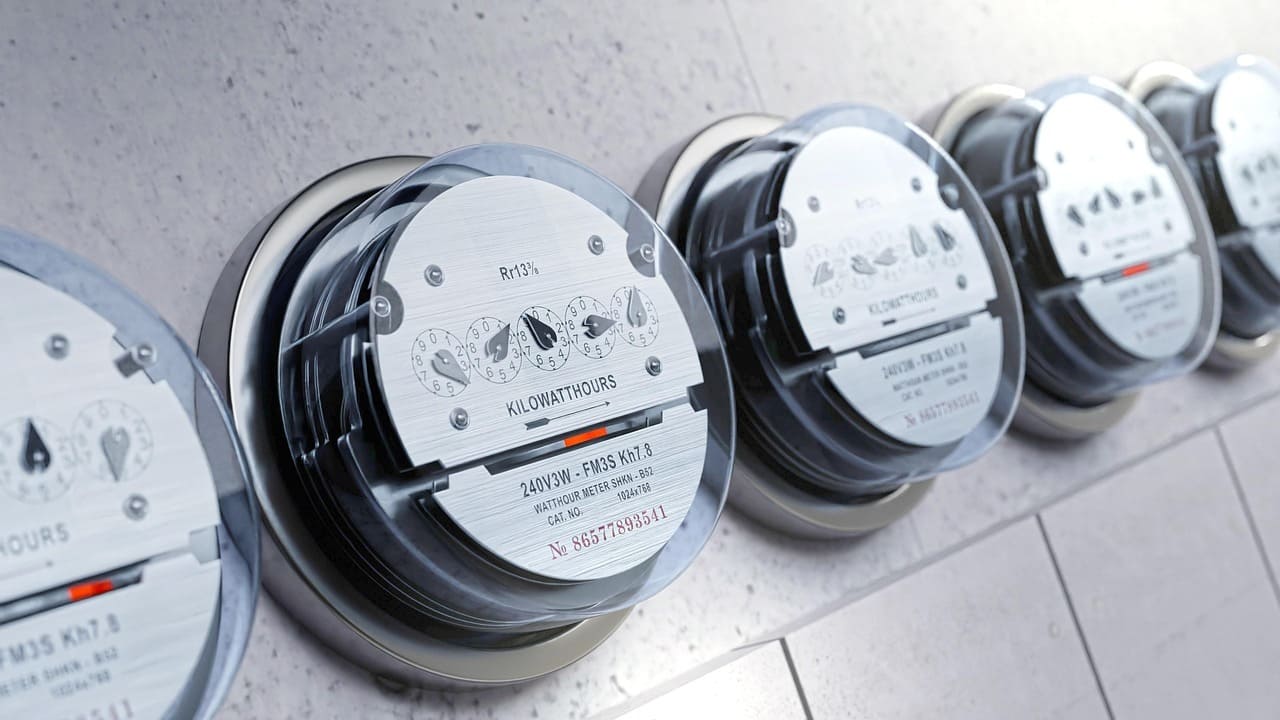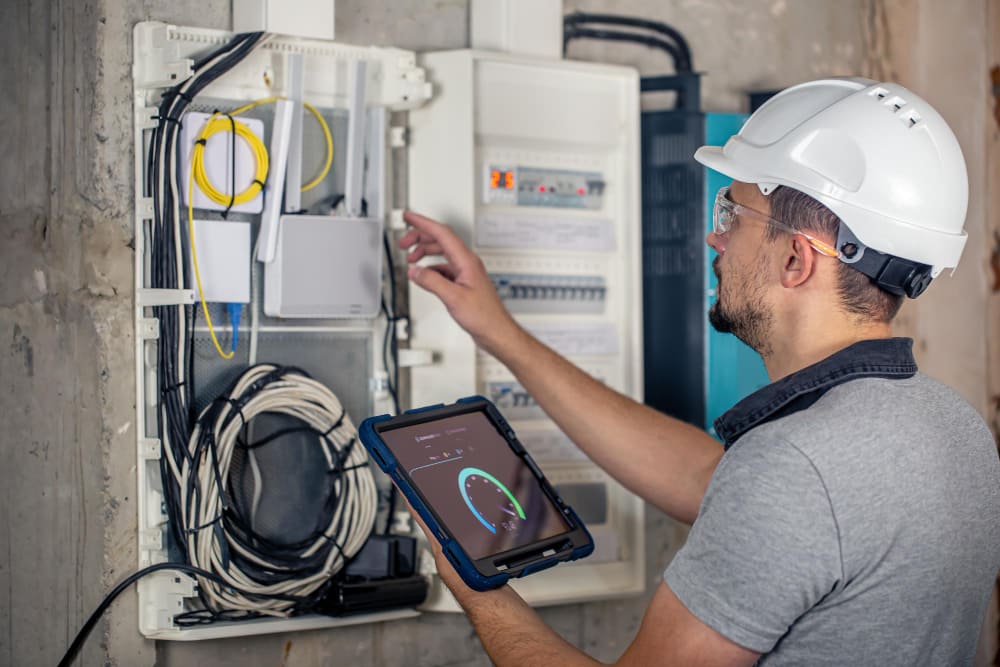

Yes, you typically need a different meter after going solar. Most grid-tied solar panel systems require a bidirectional meter (also called a net meter or smart meter) to replace your existing utility meter. This upgrade allows measurement of both electricity consumed from the grid and excess solar energy sent back to it.
Quick Answer Summary:
A solar energy system comprises far more than solar panels alone. While panels take center stage, generating clean, cost-free power from sunlight, they can't deliver free electricity to your home without critical supporting components like inverters, distribution panels, and meters.
Meters often get overlooked as essential solar system components. Yet these devices serve as your direct link to understanding your solar investment. They reveal crucial data: your system's electricity production levels, your household's energy consumption, and the amount of grid power you're still buying from your utility provider.
This guide gives meters the spotlight they deserve. We'll break down every electricity meter type, explain how each connects to your solar setup, and clarify whether you'll need one installed.

Two primary classifications of electricity meters exist for residential and commercial properties: pass-through meters and CT meters.
Residences and smaller structures typically use these electricity meters. Their larger physical size makes them impractical for buildings requiring substantial electrical service capacity.
Commercial buildings predominantly feature CT meters. Buildings with single-phase electricity utilize two CTs, while three-phase electricity buildings require three CTs.
These meter types maintain a compact footprint, making them perfect for structures needing higher electrical service capacity. Pass-through meters would demand impractically oversized components for large buildings, including wiring, enclosures, and related hardware.
Your solar installation will include one or more of these three meter types: pass-through meters, CT meters, and meter-to-meter converters.
Traditional utility meters tracked electricity consumption in a single direction, from the power company to your property.
Solar installation creates additional metering requirements that standard one-way meters cannot satisfy. Modern solar systems utilize net meters or smart meters instead. These operate bi-directionally, accurately calculating your net energy consumption, total energy used minus solar-generated energy.
Most solar installations maintain grid connectivity. These grid-tied systems blend the cost savings and energy autonomy of off-grid solar with readily available grid electricity.
Grid-tied solar systems can offset 100% of your consumption. Yet solar production occurs only during sunlight hours, while electricity demand continues regardless of weather or time. To address this, systems are engineered to generate surplus electricity during peak sun exposure.
This excess energy becomes available when production stops but requires interim storage. Two primary storage solutions exist: battery systems or the utility grid.
Residential applications commonly employ batteries. Despite ongoing technological advances and price reductions, batteries carry substantial costs that prevent widespread homeowner adoption.
The utility grid represents the most widely adopted and economical alternative. Net metering programs, accessible in numerous states, enable excess electricity storage on the grid for utility credits. According to the Department of Energy's homeowners guide, these programs help maximize solar investment returns. During non-production periods, you withdraw grid electricity using accumulated credits.
Bi-directional utility meters become critical here. Beyond measuring grid-drawn electricity, they track electricity transferred to the grid. This net calculation displays grid additions versus grid usage, producing either a credit surplus or utility charges.
Every grid-tied solar system owner requires a bidirectional utility meter to track system-to-grid electricity transfers. Proper permit expediting services can streamline the meter approval process with your local utility company.
PV meters quantify your solar system's electricity generation. These one-directional meters operate without reverse power flow to your solar array.
They provide the most precise measurement of usable electricity generation, as panel-level or inverter-level monitoring excludes minor production losses occurring between system components.
This meter serves Solar Renewable Energy Credits (SRECs) in states with SREC markets and supports performance guarantee programs.
SRECs provide credits for every 1,000 kilowatt-hours (one megawatt-hour) your system generates. These credits sell on state SREC markets at current prices, creating additional solar system revenue.
Many reputable solar installers guarantee system performance through documented agreements. If production falls below estimates, these guarantees typically provide financial compensation for the shortfall. Solar production tracking becomes essential for maintaining these guarantees.
When selling SRECs or when your installer provides performance guarantees, PV meter installation becomes necessary.
Internet connectivity is standard for many PV meters, dramatically simplifying solar production monitoring.
Remote monitoring via computer or mobile device eliminates manual outdoor meter readings. Leading inverter manufacturers (including SolarEdge, SMA, and Enphase) partner with metering companies to integrate production data into system dashboards and online portals for convenient tracking.
Internet-enabled PV meters facilitate remote system monitoring by installers to maintain performance guarantees. Solar permit requirements in many jurisdictions now recognize these advanced monitoring capabilities as standard practice.
Most internet-connected PV meters use CT meter technology, independent of electrical service size.
Consumption meters display total electricity usage, including direct solar system consumption and utility-sourced power. CT meter technology is standard regardless of building dimensions.
When solar installers promise 100% electricity coverage but systems underperform, detailed consumption analysis proves valuable.
Consumption increases can escape notice, as minor property modifications may substantially elevate electricity usage. Alternatively, undersized solar systems may inadequately meet electricity requirements.
Consumption meters diagnose these discrepancies effectively.
Inverter manufacturers increasingly incorporate consumption monitoring into their products, providing solar owners enhanced electricity usage visibility. The National Renewable Energy Laboratory has extensively researched these monitoring technologies and their impact on system performance.
Though not mandatory for solar systems, consumption meters deliver precise usage data. Growing inverter integration of this capability suggests it will become standard solar system functionality.

Despite not being top-of-mind during solar installation, meters fulfill vital roles in understanding and tracking your solar investment. As essential components, whether for net metering, SRECs, performance guarantees, or investment confidence, they illuminate solar system operation and electricity consumption patterns.
Understanding electricity meters is fundamental to maximizing your solar investment and ensuring your system performs as expected. Whether you're monitoring production through a PV meter, tracking net energy usage with a bidirectional utility meter, or analyzing consumption patterns with a dedicated consumption meter, each metering component serves a specific purpose in your solar ecosystem.
The right metering setup empowers you to verify system performance, capitalize on programs like net metering and SRECs, and maintain complete visibility into your energy independence journey. While meters may seem like technical afterthoughts, they're actually your dashboard to understanding how effectively your solar panels are reducing your electricity costs and environmental impact.
Before finalizing your solar installation, discuss metering requirements with your installer. Confirm which meters you'll need based on your state's regulations, available incentive programs, and your personal monitoring preferences. The American Solar Energy Society provides additional resources on state-specific solar policies. With proper metering in place, you'll have the data and peace of mind to fully enjoy the benefits of clean, renewable solar energy for decades to come.
For expert guidance on solar system design and permitting, contact our team to ensure your installation meets all technical and regulatory requirements.
Will my utility company replace my meter when I install solar panels?
Yes, in most cases. When you install a grid-tied solar system, your utility company typically replaces your existing meter with a bidirectional (net) meter at no charge or for a minimal fee. This new meter measures both the electricity you consume from the grid and the excess electricity your solar system sends back. Understanding solar interconnection requirements is crucial before installation. Contact your utility provider before installation to understand their specific metering policies, replacement procedures, and any associated costs in your service area.
How do I read my solar meter to know if my system is working properly?
Reading your solar meter depends on the type installed. Bidirectional utility meters display net usage; showing whether you're currently drawing from or sending electricity to the grid. PV meters show cumulative production in kilowatt-hours (kWh). Most modern meters include digital displays with multiple screens accessible by pressing a button. However, internet-connected meters and inverter monitoring systems provide the easiest way to track performance through smartphone apps or web portals, offering real-time production data, historical trends, and instant alerts if issues arise. ENERGY STAR provides guidelines on energy monitoring best practices for homeowners.
What's the difference between a PV meter and a utility meter?
A utility meter measures the net electricity exchange between your property and the power grid, tracking both what you consume and what you export. A PV meter specifically measures only the total electricity your solar panels generate. While the utility meter determines your bill and net metering credits, the PV meter provides accurate production data needed for performance guarantees and SREC programs. Understanding three-line diagrams helps visualize how these meters connect within your solar system. Many solar installations include both meters to provide complete visibility into system performance and grid interaction.
Can I monitor my solar production without installing additional meters?
Yes, many modern solar inverters include built-in monitoring capabilities that track production data without requiring separate PV meters. Inverter manufacturers like SolarEdge, Enphase, and SMA offer monitoring platforms accessible through apps and web portals. The International Energy Agency's renewables report highlights how smart monitoring technologies are advancing rapidly. However, these inverter-based systems may not meet the accuracy requirements for SREC certification or certain performance guarantee programs, which often mandate dedicated revenue-grade PV meters. Check with your installer and local programs to determine whether inverter monitoring alone satisfies your needs or if additional metering is necessary. Supply-side connection considerations may also affect your metering requirements.
Do I need to pay for internet service to monitor my solar meters?
Internet connectivity for solar meter monitoring typically uses your existing home Wi-Fi network at no additional cost beyond your regular internet service. The meters themselves connect to your router, usually requiring only a one-time setup. Some systems offer cellular connectivity options for properties without reliable Wi-Fi, which may involve monthly data fees. However, internet connection isn't mandatory for meter operation; it simply enables remote monitoring convenience. Green building practices increasingly emphasize integrated monitoring systems for optimal energy management. Meters will continue measuring and storing data locally even without internet access, though you'll need to read them manually on-site. For comprehensive guidance on system monitoring and rapid shutdown compliance, explore our additional resources in the blog section.
We are dedicated to providing top-notch solar permit services to homeowners, business owners, DIY, and solar installers. Contact us today.